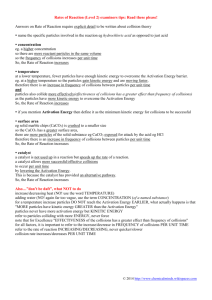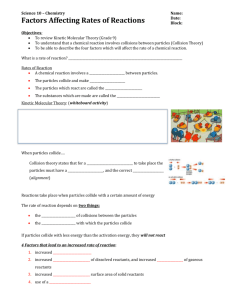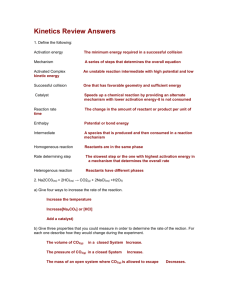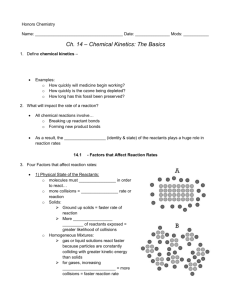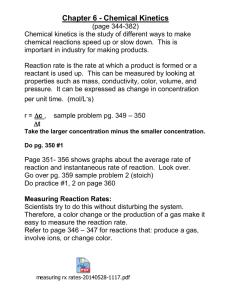Reaction Rate review questions
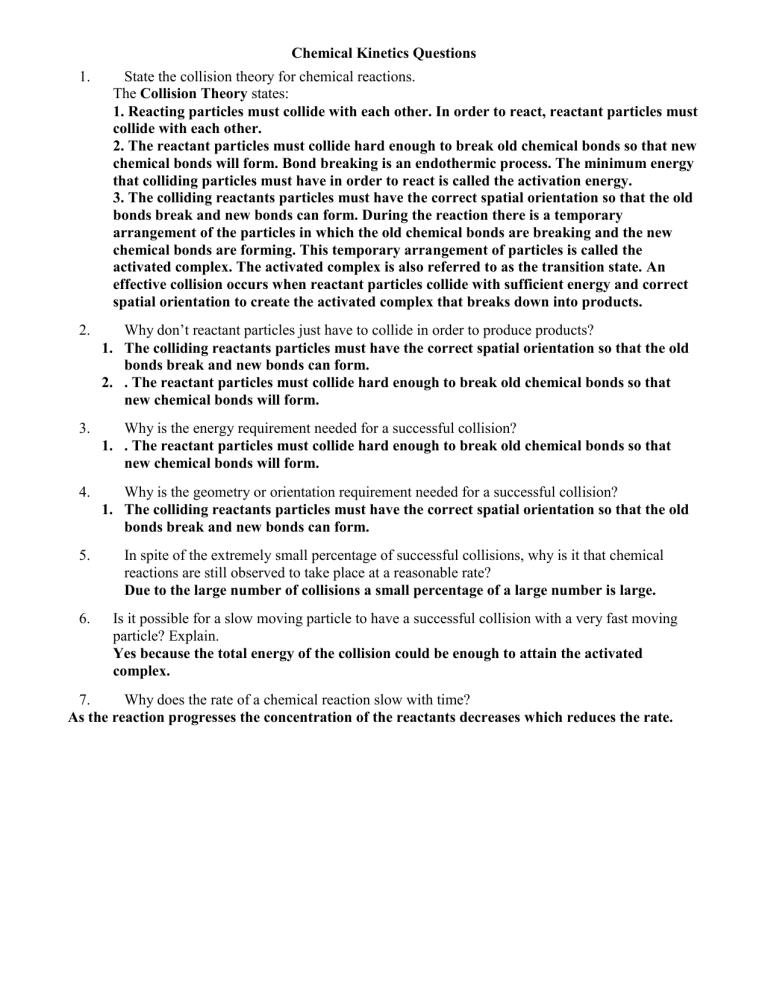
Chemical Kinetics Questions
1.
State the collision theory for chemical reactions.
The Collision Theory states:
1. Reacting particles must collide with each other. In order to react, reactant particles must collide with each other.
2. The reactant particles must collide hard enough to break old chemical bonds so that new chemical bonds will form. Bond breaking is an endothermic process. The minimum energy that colliding particles must have in order to react is called the activation energy.
3. The colliding reactants particles must have the correct spatial orientation so that the old bonds break and new bonds can form. During the reaction there is a temporary arrangement of the particles in which the old chemical bonds are breaking and the new chemical bonds are forming. This temporary arrangement of particles is called the activated complex. The activated complex is also referred to as the transition state. An effective collision occurs when reactant particles collide with sufficient energy and correct spatial orientation to create the activated complex that breaks down into products.
2.
Why don’t reactant particles just have to collide in order to produce products?
1.
The colliding reactants particles must have the correct spatial orientation so that the old bonds break and new bonds can form.
2.
. The reactant particles must collide hard enough to break old chemical bonds so that new chemical bonds will form.
3.
Why is the energy requirement needed for a successful collision?
1.
. The reactant particles must collide hard enough to break old chemical bonds so that new chemical bonds will form.
4.
Why is the geometry or orientation requirement needed for a successful collision?
1.
The colliding reactants particles must have the correct spatial orientation so that the old bonds break and new bonds can form.
5.
In spite of the extremely small percentage of successful collisions, why is it that chemical reactions are still observed to take place at a reasonable rate?
Due to the large number of collisions a small percentage of a large number is large.
6.
Is it possible for a slow moving particle to have a successful collision with a very fast moving particle? Explain.
Yes because the total energy of the collision could be enough to attain the activated complex.
7.
Why does the rate of a chemical reaction slow with time?
As the reaction progresses the concentration of the reactants decreases which reduces the rate.
Chemical Kinetics Questions
8.
Sketch a graph of : a) [ ] of reactant vs time; b) [ ] of product vs time
9.
Calculate the average rate of a chemical reaction if the concentration of reactant Y is 0.45 M at
3.0 min and 0.20 M after 8.0 min.
R = - (0.20 M - 0.45 M) = 0.05
(8.0 min – 3.0min)
10.
Why is it referred to as average rate that we are calculating for a reaction time interval?
Rate is constantly reducing as the concentrations of the reactants are decreasing.
11.
Analyze the activation energy diagram shown below for the hypothetical reaction:
E + 2F
G + H and answer the following questions: i) What is the activation energy for the forward reaction? E
Af
= 40 J
The reverse reaction? E
Ar
100 J ii) What is the value of
H for the forward reaction?
H = -60JThe reverse reaction?
H = +60J iii) What is the energy of the activated complex? Act Complex = 120J
Chemical Kinetics Questions
12.
The following hypothetical reaction has activation energy of 120 kJ and a
H of 80 kJ.
2A + B
2C + D i) Draw and label a potential energy diagram for this reaction. ii) Calculate the activation energy for the reverse reaction.
13.
Explain how concentration affects the rate of a reaction.
[ ] is directly related to Rate – as [ ] increases Rate increases – more particles leads to more collisions.
14.
Explain how temperature affects the rate of a reaction.
As temperature increases particles move faster leading to more and harder collisions which causes an increase in reaction rate.
15.
Explain how amount of surface area affects the rate of a reaction.
Greater surface area exposes more particles for collisions which causes an increase in reaction rate.
16.
Explain how a catalyst affects the rate of a reaction.
The presence of a catalyst leads to the formation of an alternative activated complex which is lower in activation energy. More collisions will have the energy of activation and the reaction rate will increase.
17.
Explain why a match has little effect on lighting a lump of coal, yet a spark can cause coal dust to ignite with explosive force.
Coal dust as a huge surface area so the number of particles available for collision causes almost all to react at once – an explosion.
18.
Which of the factors that affect the rate of a reaction affect the collision frequency (number of collisions per second)?
Temperature, concentration and surface area all affect the number of collisions per second – catalyst and nature of reactants does not.
Chemical Kinetics Questions
19.
Why is the following reaction not likely to take place in one step:
4HBr(g) + O
2
(g)
2H
2
O(g) + 2Br
2
(g)
Too many particles must hit with the proper orientation – the chance of 5 in one collision is highly unlikely.
20.
The above reaction in question number 19 is believed to take place in the following three steps: i) HBr(g) + O
2
(g)
HOOBr(g) Slow ii) HOOBr(g) + HBr(g)
2HOBr(g) Fast iii) 2HOBr(g) + 2HBr(g)
2H
2
O(g) + 2Br
2
(g) Fast
4HBr(g) + O
2
(g)
2H
2
O(g) + 2Br
2
(g) a) Add the three steps to show it gives the overall reaction:
4HBr(g) + O
2
(g)
2H
2
O(g) + 2Br
2
(g) b) Identify any reaction intermediates or catalysts.
HOOBr and HOBr are intermediates, no catalyst. c) Which step is the rate-determining step? Explain.
Step i) is the rate-determining step because it is the slowest step.
21.
Given the following steps in a hypothetical chemical reaction:
C + D
E Fast
E + C
F + G Slow
F + H
C + K Fast
C
D + H
G + K i) Identify the rate-determining step. Explain.
Step 2 because it is the slowest step. ii) Identify any catalysts or intermediates.
E and F are intermediates because they are produced and then consumed.
C is a catalyst because it is there at the beginning and is there at the end, is not consumed by the reaction. iii) Write the overall balanced equation for the reaction.
Chemical Kinetics Questions
22.
Given the reaction
CH
3
NNCH
3
(g)
C
2
H
6
(g) + N
2
(g)
Time (min) [CH
3
NNCH
3
] (mol/L)
0 1.50X10
-2
10
20
30
1.29X10
-2
= 0.00021
1.10X10
-2
= 0.00019
0.95X10
-2 = 0.00015
a) Calculate the average rate of reaction for each of the following time intervals: i) 0 – 10 min ii) 10 – 20 min iii) 20 – 30 min b) How do the rates for the above time intervals compare ? Rates decrease . c) How do you explain the differences in rates for the different time intervals? As [CH
3
NNCH
3
] decreases the number of collisions decrease leading to a lower rate. d) Plot a graph of concentration of CH
3
NNCH
3
(y-axis) versus time (x-axis). e) What is the predicted concentration of CH
3
NNCH
3
after 15 min. 0.012 M
23.
The following is the proposed reaction mechanism for a chemical reaction:
NO + Cl
2
↔ NOCl
2
(Fast)
NOCl
2
+ NO ↔ 2NOCl (Slow)
2NO + Cl
2
↔ 2NOCl i) What is the net overall reaction? ii) Identify any reaction intermediates or catalysts . NOCl
2 iii) What is the rate-determining step? Explain. Step 2 is the slowest so it is the rate determining step.
Chemical Kinetics Questions
24.
Draw and label an activation (potential) energy diagram for an endothermic reaction to show the effect of a catalyst on the rate of a reaction.
25.
The following hypothetical reaction has activation energy of 140 kJ and a ∆H = –90 kJ.
Y + Z
2A + F i) Draw and label a potential energy diagram for this reaction. ii) Calculate the activation energy for the reverse reaction . 230kJ iii)
What is the ∆H for the reverse reaction
? + 90 kJ
26.
Why is there concern over explosions taking place at sawmills or grain storage buildings?
Dust increases surface area so all will react at once.
27.
Which of the five factors that affect the rate of a reaction increases the rate by increasing the fraction of collisions that are successful?
Temperature and catalyst.
Chemical Kinetics Questions
28.
What are two advantages of using a catalyst to speed up a chemical reaction rather than using heat?
Lower temperature less danger of a side reaction and catalyst is not consumed.
29.
Name two things that a catalyst does not change in a chemical reaction.
The products and ∆H.
30.
Analyze the activation energy diagram shown below for the hypothetical reaction
G + 2H
P + 2M i) What is the activation energy for the forward reaction?
60kJ the reverse reaction?
30 kJ ii) What is the value of ∆H for the forward reaction? ∆H = +30 the reverse reaction?
∆H = -30 iii) What is the energy of the activated complex? 120kJ
31.
Which of the five factors that affect the rate of a reaction is illustrated in each of the following: a) Food is sometimes frozen before it is used. Temperature b) Small sticks of wood are often used to start a fire. Surface area c) In hospitals the healing process is often quickened in an oxygen tent. Concentration
32.
Why would you expect the rate of
Ag + (aq) + Cl (aq)
AgCl(s) at room temperature is much faster than the rate of
CH
4
(g) + 2O
2
(g)
CO
2
(g) + 2H
2
O(l) at room temperature?
Greater surface area and bond are already broken.
33.
The rates of two chemical reactions are compared. Both reactions do not involve solids; the concentrations of the reactants are the same; the reactions are run at the same temperature; and neither reaction uses a catalyst. The rates of the two reactions are quite different. Explain.
The rate of reaction is determined by the nature of the reactant.
34.
A certain hypothetical reaction occurs in only one step as written:
A + B + C
D + E
Explain why you would expect this reaction to be slow.
The collision involves three different particles which must collide with the correct spatial orientation and the correct amount of energy to attain the activated complex.
Chemical Kinetics Questions
35.
Below is an activation energy diagram for an endothermic reaction. Redraw the diagram to show the effect of a catalyst on the rate of the reaction and explain.
36.
The decomposition of nitrogen dioxide
2NO
2
2NO + O
2 is believed to take place in two steps. The first step is
NO
2
+ NO
2
2NO + 2O
O + O
O
2
2NO
2
2NO + O
.
2
Predict a possible second step.
37.
For the reaction
2H
2
O
2
(l)
2H
2
O(l) + O
2
(g) the suggested mechanism is
H
2
O
2
+ I -
H
2
O
2
H
+ IO
-
2
O + IO
H
2H
2
O
2
(l)
2H
2
2
(Slow)
O + O
2
+ I
-
O(l) + O
2
(g)
(Fast) a) Show that the sum of the steps in the reaction mechanism equals the overall equation for the reaction. b) What is the rate-determining step in this reaction? Explain.
Step one is the slowest so it is the rate determining step. c) Identify and label any intermediates or catalysts.
Intermediate - IO catalyst - I -
Chemical Kinetics Questions
38.
Given the reaction
2NO
2
+ F
2
2NO
2
F with the suggested mechanism
NO
2
+ F
2
NO
F + NO
2
NO
2
2
F + F (Slow)
F (Fast)
2NO
2
+ F
2
2NO
2
F a) Show that the sum of the two steps in the reaction mechanism is the same as the overall equation for the reaction. b) What is the rate-determining step? Explain . First step is the slowest so it is the rate determining step. c) Identify any intermediates or catalysts. F is an intermediate, no catalyst . d) Predict why step one should be slower than step two.
Step one involves bond breakage while step 2 is bond formation.
39.
Given the reaction
Zn(s) + 2HCl(aq)
ZnCl
2
(aq) + H
2
(g)
What would be the effect on the rate of reaction if a) Powdered zinc was added to the zinc instead of a solid piece of zinc metal – increase in surface area will increase the reaction rate. b) The concentration of HCl(aq) was doubled. The reaction rate will double due to doubling the number of colliding particles.
40.
Examine the potential energy diagram of a reaction that proceeds from reactant A to product D as shown. Then, answer the accompanying questions. a) Is the overall reaction exothermic or endothermic?
Reaction is endothermic the products are higher in PE ∆H is +. b) Which step is most likely to be the rate-determining step? Give a reason for your answer.
Step 2 is most likely to be the rate-determining step because it has the largest E
A
. c) Where would an activated complex be indicated on this diagram?
Activated complex occur at E, F and G. d) What type of compound exists at B?
An intermediate exists at B.




